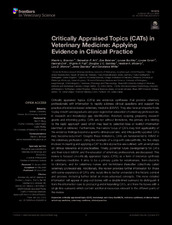| dc.creator | Brennan, Marnie L. | |
| dc.creator | Arlt, Sebastian P. | |
| dc.creator | Belshaw, Zoe | |
| dc.creator | Buckley, Louise | |
| dc.creator | Corah, Louise | |
| dc.creator | Doit, Hannah | |
| dc.creator | Fajt, Virginia R. | |
| dc.creator | Grindlay, Douglas J. C. | |
| dc.creator | Moberly, Heather K. | |
| dc.creator | Morrow, Lisa D. | |
| dc.creator | Stavisky, Jenny | |
| dc.creator | White, Constance | |
| dc.date.accessioned | 2020-09-06T18:48:40Z | |
| dc.date.available | 2020-09-06T18:48:40Z | |
| dc.date.issued | 2020-06 | |
| dc.identifier.citation | Brennan ML, Arlt SP, Belshaw Z, et al. Critically Appraised Topics (CATs) in Veterinary Medicine: Applying Evidence in Clinical Practice. Front Vet Sci. 2020;7:314. doi:10.3389/fvets.2020.00314 | en |
| dc.identifier.uri | https://hdl.handle.net/1969.1/188911 | |
| dc.description.abstract | Abstract
Critically appraised topics (CATs) are evidence syntheses that provide veterinary professionals with information to rapidly address clinical questions and support the practice of evidence-based veterinary medicine (EBVM). They also have an important role to play in both undergraduate and post-registration education of veterinary professionals, in research and knowledge gap identification, literature scoping, preparing research grants and informing policy. CATs are not without limitations, the primary one relating to the rapid approach used which may lead to selection bias or restrict information identified or retrieved. Furthermore, the narrow focus of CATs may limit applicability of the evidence findings beyond a specific clinical scenario, and infrequently updated CATs may become redundant. Despite these limitations, CATs are fundamental to EBVM in the veterinary profession. Using the example of a dog with osteoarthritis, the five steps involved in creating and applying a CAT to clinical practice are outlined, with an emphasis on clinical relevance and practicalities. Finally, potential future developments for CATs and their role in EBVM, and the education of veterinary professionals are discussed. This review is focused on critically appraised topics (CATs) as a form of evidence synthesis in veterinary medicine. It aims to be a primary guide for veterinarians, from students to clinicians, and for veterinary nurses and technicians (hereafter collectively called veterinary professionals). Additionally, this review provides further information for those with some experience of CATs who would like to better understand the historic context and process, including further detail on more advanced concepts. This more detailed information will appear in pop-out boxes with a double-lined surround to distinguish it from the information core to producing and interpreting CATs, and from the boxes with a single line surround which contain additional resources relevant to the different parts of the review.
Keywords: BestBETs; clinical practice; critically appraised topic (CAT); evidence synthesis; evidence-based veterinary medicine; knowledge summary; veterinary medicine. | en |
| dc.language.iso | en | |
| dc.publisher | Frontiers | |
| dc.rights | Attribution 4.0 International | en |
| dc.rights.uri | http://creativecommons.org/licenses/by/4.0/ | |
| dc.subject | Critically Appraised Topics (CATs) | en |
| dc.subject | Evidence-based Veterinary Medicine | en |
| dc.subject | Research Syntheses | en |
| dc.subject | Veterinary Medicine | en |
| dc.subject | Methodology | en |
| dc.subject | Evidence synthesis | en |
| dc.subject | clinical veterinary practice | en |
| dc.subject | Knowledge Summary | en |
| dc.subject | Best Bets | en |
| dc.title | Critically Appraised Topics (CATs) in Veterinary Medicine: Applying Evidence in Clinical Practice | en |
| dc.type | Article | en |
| local.department | Veterinary Physiology and Pharmacology | en |
| local.department | University Libraries | en |
| dc.identifier.doi | 10.3389/fvets.2020.00314 | |



